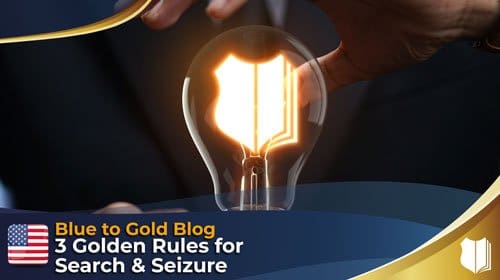These three golden rules come from reading thousands of court cases over the last 20 years and seeing a theme regarding what the courts are looking for.
The First Golden Rule, and the most important one, is:
The more you articulate why you did something, the more likely it will be upheld in court.
The reason for this is, first of all, that the Fourth Amendment prohibits unreasonable searches and seizures. In other words, if what you did was reasonable, it’s lawful. But what is reasonable depends on the totality of the circumstances.
That means that every fact and circumstance comes into play. One change in a fact or one change in the circumstances of something can determine whether it was reasonable or unreasonable. So you need to tell the court why you did what you did. This is an objective standard.
You can’t go into court and say, “Your Honor, I was reasonable, because I sincerely believed that what I was doing was reasonable.” The courts will thank you for that feedback, but they require an objective standard. So it’s kind of like taking all the facts and the circumstances that you had and putting them into this “objective standard” computer. If it prints out that it would do a similar thing to what you did, then the court would say, “Okay, that was reasonable.” But the key is that you want to give that computer as much data as possible.
And so the final point here is that when you do your report, you want to talk about three factors in the encounter, whether it was a consensual encounter, a Terry Stop, a use of force, etc. The first factor is police. Talk about what the police did, what you did. What did your partners do? What resources did you have? What resources did you not have, and so forth?
The next factor is the suspect. What did the suspect say, or do? What was he wearing? For example, was it gang attire? Were there any weapons present? What is his criminal history, and so on?
And finally, talk about the environment. Where did this encounter take place? Was it at night? Was it in a desolate area? Was it in a high crime area, and so forth? Was it where there were people around, potential confederates of the suspect? You want to talk about all those things, and lay it out for the court.
The second golden rule is:
The more serious the crime, the more reasonable your actions are likely to be viewed by the court.
This is very important. For example, if you have reasonable suspicion to stop a person for a suspected sexual assault, you pull out your weapon, you point your gun at them, and you say, “Get on the ground.” Then you pat them down, and you find a weapon and drugs and so forth. Then, later, the suspect says, “When he pointed that gun at me, I felt like I was under arrest.” A reasonable person in those circumstances would feel like they were under arrest, and the courts are more likely to say, “Pointing a firearm in those circumstances was reasonable, because there was a serious offense.”
The courts are going to bend over backwards to find that your response and actions were reasonable when it’s a serious offense. But if it’s a minor offense, then they’re going to put the whole weight on your shoulders to basically persuade the court that what you did was reasonable. So if you pulled out your firearm and pointed it at somebody suspected of stealing a candy bar at Walmart, the courts will more likely than not find that it was excessive for that situation. That was a de facto arrest, and for that you needed probable cause. Many courts around the nation today find that pointing a firearm at somebody without good cause is force and it has to be justified. So that’s the second golden rule.
The Third Golden Rule is:
Conduct all warrantless searches and seizures in the same manner as if you had a warrant.
When you conduct a warrantless search or seizure, which is 95% of police work, you don’t have any extra powers that the court couldn’t have given you. An example is if you have probable cause that there’s a stolen MacBook Pro in a vehicle and you want to get a warrant. What would the judge tell you?
He would tell you to look for that MacBook Pro. The judge has said, “You can look in the trunk and in bags that could contain the item.” But if you ask the judge, “Can I look in an eyeglass case?” the judge is going to say, “No, the MacBook Pro cannot be in an eyeglass case.” So when you’re conducting a warrantless search or seizure, you also can’t look in the eyeglass case for that stolen MacBook Pro. That’s just the point; when you’re thinking about the scope of your warrantless search or seizure, you want to keep in mind what the courts would allow you to do.
Those are the three golden rules. If you keep them in mind while in the field, your courtroom experience should be less stressful.










